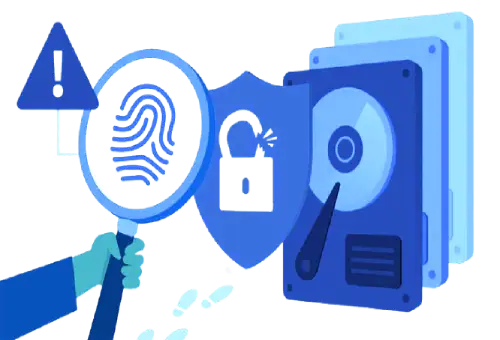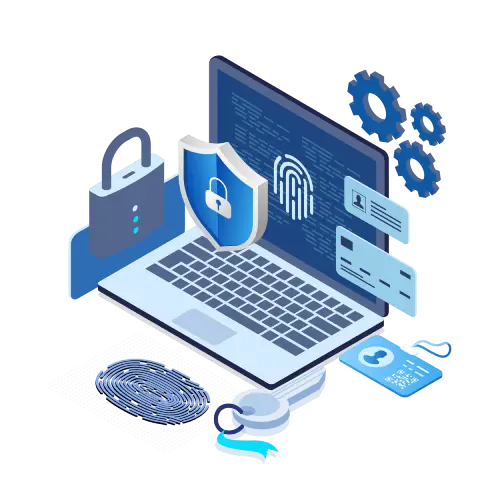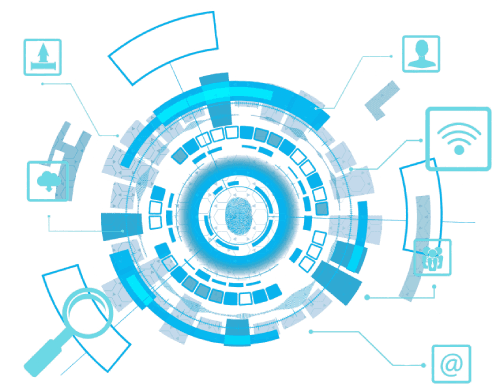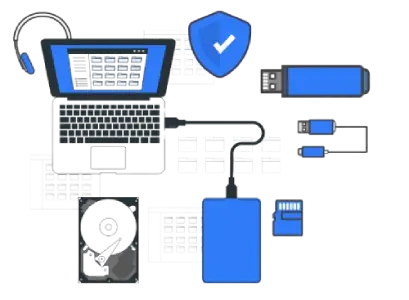Services
/Digital Forensic Investigation Services

As society increases reliance on computer systems and cloud computing, digital forensic becomes a crucial aspect of law enforcement agencies and businesses. Digital forensic is the most intricate step of the cybercrime investigation process, and often yields the strongest evidence in terms of prosecutable cases. Digital forensic is the scientific acquisition, analysis, and preservation of data contained in electronic media whose information can be used as evidence in a court of law.
The goal of the process is to preserve any evidence in its most original form while performing a structured investigation by collecting, identifying, and validating the digital information to reconstruct past events. All processes utilize sound forensic techniques to ensure the findings are admissible in court.
Digital Forensic Investigation Process:
Digital forensic investigations commonly consist of four stages:
- Seizure: Prior to actual examination digital media is seized by the digital forensic examiner and the chain of custody maintained.
- Acquisition: Once devices are seized, a forensic duplicate of the data is created using a hard drive duplicator or software imaging tool. Then the original drive is stored securely to prevent tampering. The acquired image is verified with SHA-1 or MD5 hash functions and will be verified again throughout analysis to verify that the evidence is still in its original state.
- Analysis: After acquisition, the forensic examiner recovers evidence using a number of methods (and tools), often beginning with the recovery of deleted information. The type of data analysed are email, chat logs, images, internet history and documents.
- Reporting: Once the investigation is complete, the information is collated into a report that is accessible to non-technical individuals. It may include audit information or other meta-documentation.
Legal Considerations of Digital forensic:
The examination of digital media is covered by national and international legislation. In general, laws dealing with digital evidence are concerned with:
- Integrity: Ensuring the act of seizing and acquiring digital media does not modify the evidence (either the original or the copy).
- Authenticity: The ability to confirm the integrity of information. The chain of custody from crime scene through analysis and ultimately to the court, in the form of an audit trail, is an important part of establishing the authenticity of evidence.
Why ANA Cyber?
ANA Cyber Forensic Pvt Ltd is a specialized Digital forensic and Information Security Services Company with a Cyber Forensic Lab to uncover all sorts of cyber frauds. We help enterprises to identify, prevent, detect, resolve, and protect their critical data from threats, crimes, frauds, and acts of terrorism arising due to vast proliferation and usage of the Digital medium in personal and professional lives. We also provide assistance for legal enforcement to customers.
Differentiating Factors:- Compliant Pvt. Ltd. Company.
- We have a Cyber Forensic Lab to uncover all sorts of cyber frauds.
- Presence of Techno-Legal experts.
- ISO 27001:2013 certified company.
- Complete confidentiality is maintained by signing an NDA with employees who are working on project/Assignment
- We have a strong legal team that backs up our forensic team by providing consultancy on various information technology based statutes like, Information Technology Act, 2000 (Amended till 2008).
- Digital Forensic Investigation Lab, Skilled Cyber Forensic Experts.
- Expert witnesses in courts.
- Impressive track record with niche client portfolio.
- Preservation of digital evidence following best practices in the industry.
- Customize Information Security Services as per client need.
Services Offered
- Computer Forensic Investigation
- E-Mail Forensic
- Incident Response
- Data Leak Analysis
- Data Recovery
- Cyber Crime And Fraud Investigation
Computer Forensic Investigation
Computer forensic investigation and analysis is a techniques to gather and preserve evidence from a particular computing device in a way that is suitable for presentation in a court of law. The goal of computer forensic investigation is to perform a structured investigation and maintain a documented chain of evidence to find out exactly what happened on a computing device and who was responsible for it.
Why is computer forensic important?Computer forensic helps ensure the integrity of digital evidence presented in court cases. As computers and other data-collecting devices are used more frequently in every aspect of life, digital evidence and the forensic process used to collect, preserve and investigate it has become more important in solving crimes and other legal issues.

Computer Forensic Investigation starts with the collection of information in a way that maintains its integrity. Investigators then analyse the data or system to determine if it was changed, how it was changed and who made the changes. The use of computer forensic isn't always tied to a crime. The forensic process is also used as part of data recovery processes to gather data from a crashed server, failed drive, reformatted operating system (OS) or other situations where a system has unexpectedly stopped working.
Types of computer forensicThere are various types of computer forensic examinations. Each deals with a specific aspect of information technology. Some of the main types include the following:
- Database forensic: The examination of information contained in databases, both data and related metadata.
- Email forensic: The recovery and analysis of emails and other information contained in email platforms, such as schedules and contacts.
- Malware forensic: Sifting through code to identify possible malicious programs and analysing their payload. Such programs may include Trojan horses, ransomware or various viruses.
- Memory forensic: Collecting information stored in a computer's random access memory (RAM) and cache.
- Network forensic: Looking for evidence by monitoring network traffic, using tools such as a firewall or intrusion detection system.
- Mobile forensic: Mobile forensic is a branch of digital forensic related to the recovery of digital evidence from mobile devices in such a way that the evidence is preserved in a forensically sound condition.
The growing need for mobile device forensic is driven by:- Use of mobile phones to store and transmit personal and corporate information
- Use of mobile phones in online transactions
Data collection:
- Electronically stored information must be collected in a way that maintains its integrity. This often involves physically isolating the device under investigation to ensure it cannot be accidentally contaminated or tampered with.
- Examiners make a digital copy, also called a forensic image, of the device's storage media, and then they lock the original device in a safe facility to maintain its pristine condition. The investigation is conducted on the digital copy.
- Investigators analyse digital copies of storage media in a sterile environment to gather the information for a case.
- Various tools are used to assist in this process, including Basis Technology's Autopsy for hard drive investigations.
- The forensic investigators present their findings in a legal proceeding, where a court uses them to help determine the result of a lawsuit.
- In a data recovery situation, forensic investigators present what they were able to recover from a compromised system.
E-Mail Forensic
Emails play an important role in business communications.The negative side of emails is that criminals may leak important information about their company. Hence, the role of emails in digital forensic has been increased in recent years. E-Mails are one of the most crucial evidentiary factors in almost every case litigated nowadays. Many a times E-Mails are either intentionally erased or accidently deleted by users. In digital forensic, emails are considered as crucial evidences and Email Header Analysis has become important to collect evidence during forensic process. These E-Mails can be recovered from their HDDs and source files stored on the system or E-Mail servers.

Email forensic is the analysis of source and content of the email message, identification of sender and receiver, date and time of email and the analysis of all the entities involved. Email forensic also reforms the forensic of client or server systems suspected in an email forgery.
Some of the techniques which are used for email forensic investigation are- Header Analysis
- Server investigation
- Network Device Investigation
- Sender Mailer Fingerprints
- Software Embedded Identifiers
- ANA Cyber Forensic (E-mail Recovery Experts) professionals work closely with desktop as well as web email file formats to recover and analyse e-mails.
- We hold expertise in recovering corrupted and lost PST files, data repository for Microsoft Outlook.
- Initially, we begin with analysing the storage media to ascertain reasons for data loss. It helps us discover any signs that could interrupt and prevent the recovery of data in any form.
- We image the original storage drive and start working with the cloned copy. We examine the file layout and once the directory with email files and attachments are detected, we employ advanced email recovery tools to extract the files and restore your data.
- If emails are being sent via web based services like Gmail, Yahoo, and Hotmail etc our Legal Experts will guide you with the initiation of legal proceedings for tackling the situation.
- Our ISO 27001 certification ensures full confidentiality of your organizational data. All your organizational data coming to our offices is kept confidential with the best practices of ISO 27001.
Incident Response
An intrusion or attack can be frustrating or even mentally and emotionally demanding. One can certainly be better prepared and equipped to handle such a situation judiciously. Incident Response comprises of a set of instructions for managing cyber-attack or any form of security breach. Incident Response is an organized approach to addressing and managing the aftermath of a security breach or attack (also known as, ‘incident’). The goal is to handle the situation in a way that limits damage and reduces recovery time and costs. An incident response plan includes a policy that defines what constitutes an incident and provides a step-by- step process that should be followed when such an incident occurs. Incident response (IR) plans are designed to test your company’s ability to respond to a security incident.

- Proper preparation and planning for handling an incident.
- With siloed security products, emerging threats may go unnoticed.
- Manual Incident Response tasks slow down response times, putting your organization at risk. It helps us discover any signs that could interrupt and prevent the recovery of data in any form.
- Working across disparate security products slows down incident response.
- New threats emerge daily, making security research a constant need.
- Unaware about cyber-attack.
- Evidence tampering due to lack of knowledge.
- Questionable evidences in court of law.
- Brand reputation damage.
- Segregation of duties.
- Risk of owner identification.
- Our Incident Response (IR) services help you prepare for, manage, and recover from data breaches and network attacks.
- Our experienced team uses the latest security technology to respond to attacks and reduce damage and exposure.
- ANA Cyber Forensic incident responders investigate attacks, contain the impact, take immediate remediation actions by collaborating with your organization team, and finally restore data and systems to a protected state.
- With our qualified staff members and state-of-the-art technology platform, we are always ready and equipped to respond and coordinate your cyber defence.
- Preparation: The organization educates users and IT staff about the importance of updated security measures and trains them to respond to computer and network security incidents.
- Identification: The response team is activated to decide whether a particular event is, in fact, a security incident. The team may contact the CERT Coordination Centre which tracks Internet security activity and has the updated/latest information on viruses and worms.
- Containment: The team determines how far the problem has spread and contains the problem by disconnecting all affected systems and devices to prevent further damage. The team investigates to discover the origin of the incident. The root cause of the problem is ascertained and all traces of malicious code are removed.
- Recovery: Data and software are restored from clean backup files, ensuring that no vulnerabilities remain. Systems are monitored for any sign of weakness or recurrence.
- Lessons learned: The team analyses the incident and assesses whether it was handled in a desired manner, making recommendations for superior response in the future.
Data Leak Analysis
Every enterprise possesses sensitive data and securing the same is of paramount importance. Data Leak is an unauthorized transfer of classified information from a computer or datacentre to the outside world. Data leakage can be accomplished by either mentally remembering what was seen, by physical removal of tapes, disks and reports or by rather subtle means such as data hiding (see steganography). Sensitive data of companies and organizations include Intellectual Property (IP), financial information, patient information, personal credit-card data, and other valuable data depending on the business and the industry. Data leakage imposes a serious concern today for most organizations, considering the sheer number of such incidents in the recent past and cost borne by victims which continues to increase.

- It difficult to identify data leaks occurring over encrypted channels.
- It is sometimes not easy to configure and control employees access to corporate data repositories.
- The ability to process large content that can be deployed in distributed environments where the operating nodes are owned by third-party service providers.
- Privacy is a major concern when outsourcing data leak detection to third-party vendors.
- The outsourced data to third-party vendors may be transformed or modified by different users or applications.
- Brand value and reputational damage.
- Loss of personal and financial data.
- Compromising highly sensitive data of organization.
- Loss of Intellectual Property.
- Control over data flow in organization.
- Segregation of access and control rights.
- Unmeasurable, Uncontrolled and not visible.
- Ruinous to reputation and integrity of business.
- Bad publicity for organization in market.
- We help companies and organizations to detect and perform analysis of possible vulnerabilities with regard to data leakage via electronic medium.
- Our expertise involves strategic definition of the tools and techniques used to uncover the facts surrounding the breach.
- Our approach will be carefully phased to allow you to control, prioritise and guide the investigation.
- Our expert professionals work closely with your team to understand data processing channels and equipment.
- Our experts have unparalleled experience in the use of forensic software and protocols to perform data collection and data preservation in the wake of a data leak.
- We handle evidence with proven, forensically sound methodology, using data recovery tools and processes that are supported by case law.
- We also have the experience to accurately interpret findings, turning data points into a clear story and timeline that can be presented in a court of law.
Data Recovery
Data recovery is a process of retrieving inaccessible, lost, corrupted, damaged, or formatted data from secondary storage devices, removable media, or files. The common causes of data loss include power outages, natural disasters, equipment failures or malfunctions, accidental deletion of data, unintentionally formatting a hard drive, damaged hard drive read/write heads, software crashes, logical errors, firmware corruption, continued use of a computer after signs of failure, physical damage to hard drives, laptop theft, etc.

- Logical Recovery
- Firmware Corruption
- Mechanical Failure
- Encrypted/Password Recovery
- Overwritten Data Recovery
- Electronic Recovery
- Failure of drives
- Unreliable Backup Technology
- No Valid Data Recovery Plan in Place
- Failure to invest/put in place a Data Recovery Plan
- Complexity involving Humungous Storage
- Automatic Hardware Encryption
- Monolithic SD Cards
- Improper Backup System
- Encryption or virtualization of system
- Cloud based Storage System
- Failure to test backup plan
- Use of alternate storage medium like SSD and Mobile Device
- System should be incessantly live
- ANA Cyber Forensic data recovery team uses latest tools and techniques for data recovery to recovers data from physical / logical damage.
- We provide solution for every kind of data loss, dedicated to various types of storage media.
- We have the experience of having recovered data for many organizations.
- We recover data from physically damaged Hard Drive, SSD’s, Laptop Hard drive, Server Data Recovery, Flash Drive Data recovery, SD card Recovery, Mobile data Recovery etc.
Our expert team will guide and train your employees for remedies from data loss and recommend proper access control rights. Also, extensive training shall be rendered for the purpose of system hardening to prevent data loss.
Cyber Crime And Fraud Investigation
The advent of technology has brought about a revolution in our lives. Our communications, work, recreation and even utilities have undergone a change and are being powered by technology. Thus daily transactions are now faster, easier and more convenient than ever before. However, just like brick and mortar institutions, the virtual environment has its own risks and challenges. The recent increase in cybercrimes has brought this threat to the attention of many organizations, which are now increasingly sceptical regarding the security aspects of this medium.

- The computer or a network can be a tool to commit a crime
- The computer or a network can be target of the crime
- The computer or a network can be used for any incidental purpose related to crime (For example, to keep records of illegal drug sales)
Cybercrime includes Hacking, Virus dissemination, Logic bombs, Daniel-of-Service Attack, Phishing, E-Mail bombing and spamming, Web Jacking, Cyber Stalking, Data Digging, Identity Theft, and Credit Card Fraud, Salami Slicing Attack, Software Piracy etc.
Get In Touch

Contact
For more information on how we can help you secure your data, get you compliant and protect your business, please complete the form below and one of Information security / Cyber Forensic expert and Compliance specialists will respond to you as soon as possible.


